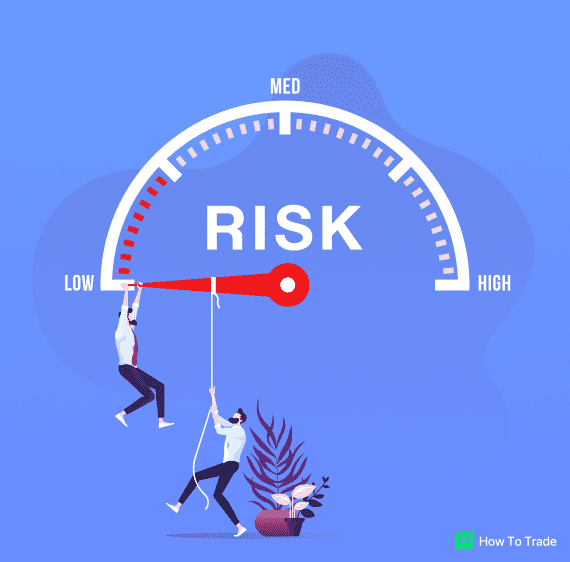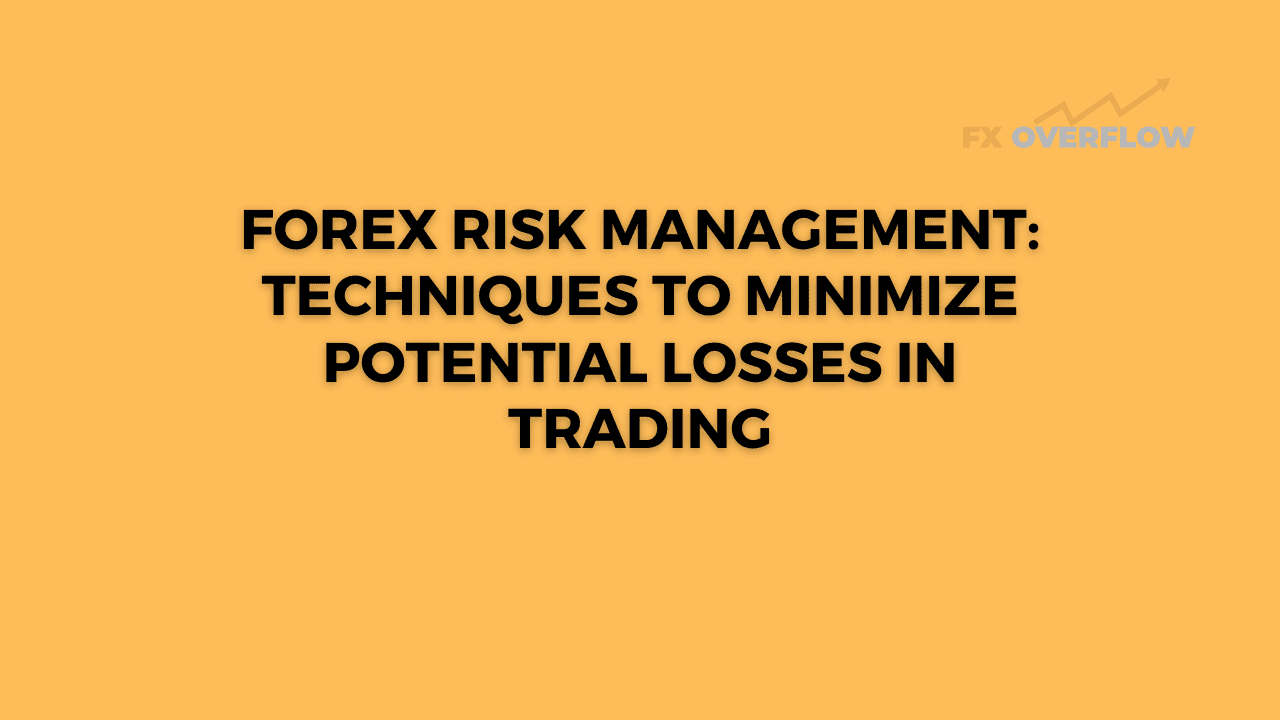Forex Risk Management: Techniques to Minimize Potential Losses in Trading
Forex trading is a highly dynamic and potentially rewarding financial endeavor. However, it comes with inherent risks that can lead to significant losses. Effective risk management is vital for traders to protect their capital and achieve long-term success in the Forex market. In this comprehensive guide, we will explore essential techniques and strategies to minimize potential losses while optimizing profit opportunities in Forex trading. Whether you're a novice or an experienced trader, these expert insights will help you navigate the volatile world of Forex with confidence and precision.

Understanding Forex Risk Management
Before diving into specific techniques, it's crucial to grasp the fundamentals of Forex risk management.
Forex risk management involves identifying, assessing, and mitigating the potential risks associated with currency trading. These risks can arise from various factors, such as economic events, geopolitical developments, and market fluctuations. By understanding and implementing effective risk management strategies, traders can safeguard their investments from adverse market conditions and unpredictable price movements.
The Importance of Risk Management in Forex Trading
Implementing a comprehensive risk management plan is a cornerstone of successful Forex trading.
Why is Risk Management Essential in Forex Trading?
Proper risk management is crucial because it allows traders to protect their trading capital from substantial losses. Without a well-defined risk management strategy, traders expose themselves to the possibility of wiping out their accounts during volatile market conditions. By applying risk management techniques, traders can preserve their capital and continue trading even during challenging periods.
Setting Risk Tolerance Levels
Defining risk tolerance levels is a fundamental step in effective Forex risk management.
How to Determine Your Risk Tolerance?
Assessing your risk tolerance involves evaluating your financial goals, trading experience, and emotional capacity to handle potential losses. It's essential to strike a balance between risk and reward that aligns with your trading objectives and risk appetite.
Position Sizing Techniques
Position sizing refers to determining the appropriate amount of capital to invest in each trade.
Understanding Position Sizing Methods
Various position sizing methods, such as Fixed Fractional Method, Kelly Criterion, and Fixed Ratio Method, help traders manage their trades based on risk and market conditions. Implementing the right position sizing technique can help optimize profits while minimizing
potential losses.
Diversification Strategies in Forex Trading
Diversification is a crucial risk management technique that involves spreading investments across different currency pairs and asset classes.
Benefits of Diversification in Forex Trading
Diversification reduces the impact of adverse market movements on a trader's overall portfolio. By not putting all their eggs in one basket, traders can protect their capital and maintain a more balanced risk profile.
Using Stop-Loss and Take-Profit Orders
Stop-loss and take-profit orders are essential tools for managing risk and locking in profits.
· How to Effectively Use Stop-Loss Orders?
Stop-loss orders help traders limit potential losses by automatically closing a trade when it reaches a predetermined price level. Implementing stop-loss orders ensures that traders exit losing trades before significant losses occur.
· How to Effectively Use Take-Profit Orders?
Take-profit orders allow traders to secure their gains by closing a trade when it reaches a specific profit target. This helps traders avoid the temptation of holding onto winning trades for too long, thus reducing the risk of giving back profits.
Risk-Reward Ratio: Striking the Balance
The risk-reward ratio is a critical metric that assesses the potential return on investment relative to the amount of risk taken.
Finding the Optimal Risk-Reward Ratio
An optimal risk-reward ratio varies depending on the trading strategy and individual preferences. Maintaining a favorable risk-reward ratio is essential for long-term profitability and risk management.
Emotions and Trading: Keeping a Clear Mind
Controlling emotions is a crucial aspect of effective risk management in Forex trading.
How to Manage Emotions While Trading?
Emotions, such as fear and greed, can cloud judgment and lead to impulsive decisions. Developing emotional discipline and maintaining a clear mind is essential to sticking to your risk management plan and avoiding irrational trades.
Utilizing Forex Hedging Strategies
Hedging is a risk management technique that involves offsetting potential losses by opening opposite positions.
Understanding Forex Hedging Techniques
Forex hedging helps protect against adverse market movements, especially during uncertain times. Common hedging strategies include using currency pairs with negative correlations or employing options and futures contracts.
The Role of Education and Practice
Continuous learning and practice are essential for improving risk management skills in Forex trading.
How Education Enhances Risk Management?
Staying informed about market developments, technical analysis, and trading strategies empowers traders to make more informed decisions and minimize risks effectively.
The Benefits of Practice Trading
Practicing with demo accounts allows traders to test their risk management strategies in a risk-free environment. Regular practice helps build confidence and sharpens trading skills.
Leveraging Fundamental and Technical Analysis
Fundamental and technical analysis are powerful tools for identifying potential risks and opportunities in the Forex market.
Using Fundamental Analysis in Risk Management
Fundamental analysis involves evaluating economic indicators, political events, and global trends to anticipate market movements and manage risks effectively.
Using Technical Analysis in Risk Management
Technical analysis involves studying price charts and patterns to identify trends and potential entry and exit points. Integrating technical analysis into risk management helps traders make well-timed decisions.
The Impact of Leverage on Risk Management
Leverage magnifies both profits and losses in Forex trading
- Understanding Leverage and Its Risks
While leverage can increase potential returns, it also amplifies the impact of market fluctuations, leading to significant losses if not used cautiously.
- Coping with Drawdowns
Drawdowns are inevitable in Forex trading and refer to periods of losses.
Strategies for Managing Drawdowns
Managing drawdowns involves sticking to your risk management plan, reducing position sizes during losing streaks, and maintaining emotional discipline.
- Evaluating and Adjusting Your Risk Management Plan
Continuous evaluation and adjustment of your risk management plan are essential for long-term success
When to Reevaluate Your Risk Management Plan?
Traders should reevaluate their risk management plan regularly, especially when market conditions change or trading strategies evolve.
- Risk Management Tools and Software
Various tools and software can assist traders in managing risk effectively.
Popular Risk Management Software
Explore reputable risk management software that helps track trades, set stop-loss levels, and manage risk with ease.
- Incorporating Forex Risk Management in Trading Strategies
Integrating risk management into your trading strategies ensures consistency and discipline.
How to Implement Risk Management in Trading Strategies?
Develop a trading plan that incorporates risk management techniques, and follow it diligently to achieve long-term profitability.
Frequently Asked Questions (FAQs)
Q: How important is risk management in Forex trading?
A: Risk management is paramount in Forex trading as it protects your capital from significant losses and ensures sustainable trading over the long term.
Q: What is the optimal risk-reward ratio for Forex trading?
A: The optimal risk-reward ratio varies based on your trading strategy, but it is generally recommended to aim for a minimum of 1:2 or higher.
Q: How do I set risk tolerance levels in Forex?
A: Assess your financial goals, trading experience, and emotional capacity to determine your risk tolerance levels effectively.
Q: What are the best Forex hedging strategies?
A: Forex hedging strategies include using currency pairs with negative correlations or employing options and futures contracts.
Q: Can I minimize potential losses without stop-loss orders?
A: Stop-loss orders are essential for minimizing potential losses and are recommended in all trading strategies.
Q: How does education enhance risk management in Forex?
A: Education provides traders with the knowledge and skills needed to make informed decisions and effectively manage risks.
Footnote
Mastering Forex risk management is a vital skill for any trader looking to navigate the dynamic and volatile world of currency trading successfully. By understanding the various risk management techniques, setting appropriate risk tolerance levels, and leveraging fundamental and technical analysis, traders can minimize potential losses while maximizing profit potential. Remember, discipline, practice, and continuous learning are key to achieving consistent success in Forex trading. Safeguard your capital, stay informed, and remain disciplined, and you'll be well on your way to becoming a successful Forex trader.











Discussion